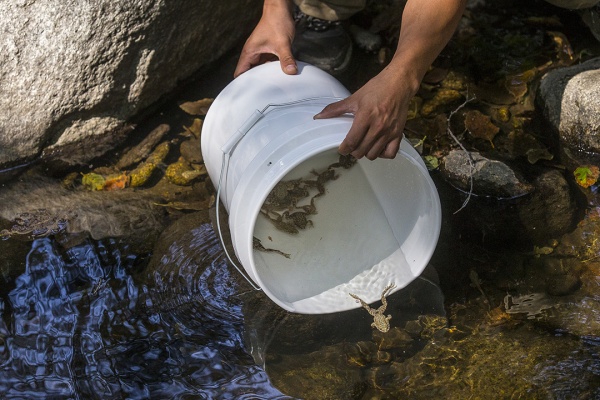Biologists are hoping to establish a future Frogtown high in the San Bernardino National Forest with the recent release of captive-bred young mountain yellow-legged frogs and tadpoles, one of the most endangered frogs in North America.
A team of staff and volunteers from the San Diego Zoo Institute for Conservation Research (ICR) introduced the young amphibians to Fuller Mill Creek with the hopes of re-establishing a foothold in the wooden habitat.

The young hoppers were bred and raised the Arnold and Mabel Beckman Center for Conservation Research in Escondido, one of the many organizations that have partnered with the San Diego Zoo ICR to save the species from extinction since 2006. They were listed endangered in 2002; fewer than 200 remained in 2003.
The Los Angeles Zoo is also a coalition partner and currently is holding two groups of wild collected tadpoles from two localities in the San Gabriel Mountains and will release them back in the San Gabes when they are old enough and the conditions are right.
The recent release in the San Bernardino Mountains included 200 tadpoles along with 27 metamorphs (frogs-in-the-making) which was the culmination of last year’s breeding season. The release site was pinpointed by the San Diego Zoo ICR along with officials at the U.S. Fish and Wildlife Service and the U.S. Geological Survey (USGS). They needed to find deep pools that had some overhang – the desired yellow-legged frog locale. Check out this video from San Diego Zoo ICR:
https://youtu.be/xYPmlXHWDBE
Mountain yellow-leggers live in perennial streams in select areas of the San Gabriel, San Bernardino and San Jacinto Mountains. They prefer cold streams 1,000 – 7, 500 feet above sea level.
Young froggies were vaccinated before release to help them battle and build up resistance to the Chytrid fungus that has taken down many wild frogs. These tadpoles and metas grow slowly (they are cold-blooded after all) and won’t be full-fledged adult frogs until next year.
The tadpoles/frogs will be monitored by the U.S.G.S. along with the San Diego Zoo ICR to see how the newbies are taking to their new digs.
The little amphib has struggled with many foes: introduced trout and bullfrog found their eggs and youngsters tasty, pesticide run-off, large wildfires that bury the stream homes under ash and debris, people swimming and splashing in waters damaging sensitive frog egg sacs. The Chytrid fungus is also affecting numerous frog species the world over.

– Brenda Rees, editor
